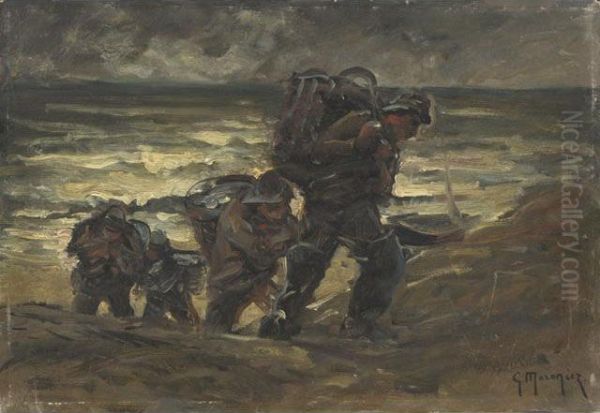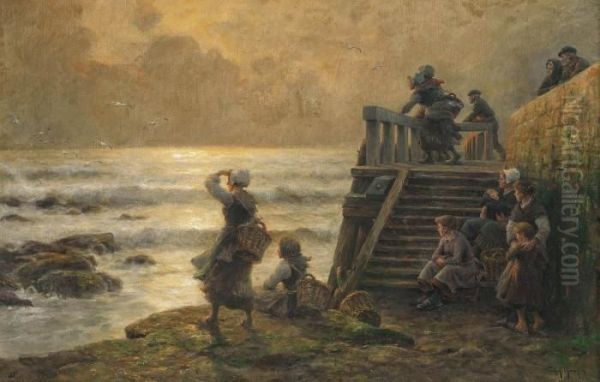Georges Philibert Charles Marionez (1865–1933) was a notable French artist whose career spanned the vibrant artistic period of the late nineteenth and early twentieth centuries. Primarily working in oils, Marionez dedicated himself to capturing the nuanced beauty of the French landscape, the dynamic life of its coastal regions, and the quiet dignity of rural existence. His work is characterized by a sensitive handling of light, meticulous brushwork, and a rich, evocative color palette, placing him firmly within the tradition of French realist and naturalist painting, while also showing an awareness of Impressionistic concerns with atmosphere and light.
It is worth noting that his surname is sometimes spelled "Maroniez," and references to "Georges P. Maroniez" likely refer to the same individual, although absolute certainty is difficult to establish from all historical records. Regardless of the minor spelling variations, his artistic identity is associated with finely rendered depictions of nature and human activity within it.
The Artistic Climate in Late 19th Century France
Marionez entered the art world during a period of significant transformation in French art. The academic traditions, centered around the École des Beaux-Arts and the official Salon de Paris, still held considerable sway, emphasizing historical subjects, polished finishes, and idealized forms. However, the latter half of the nineteenth century had witnessed revolutionary movements challenging this establishment.
Realism, championed by artists like Gustave Courbet, had already shifted focus towards the unvarnished depiction of contemporary life and landscape. Following this, the Barbizon School painters, including Jean-François Millet and Théodore Rousseau, had pioneered painting directly from nature (en plein air), focusing on rural scenes with a deep sense of place and atmosphere. Their work laid crucial groundwork for future landscape painters.

By the time Marionez was developing his style, Impressionism had exploded onto the scene. Artists like Claude Monet, Camille Pissarro, and Alfred Sisley prioritized capturing fleeting moments of light and color, often using broken brushwork and a brighter palette. While Marionez's work retains a more solid structure and detailed rendering than typical Impressionism, the movement's emphasis on light's effects and painting outdoors undoubtedly informed the atmospheric quality found in many of his canvases. He navigated a path that respected traditional techniques while embracing modern sensibilities towards subject matter and light.
Artistic Style and Technique
Georges Marionez developed a distinctive style grounded in careful observation and technical proficiency. His primary medium was oil paint, applied to canvas, wooden panels, or sometimes card supports. His brushwork is often described as fine and delicate, allowing for a high degree of detail without sacrificing overall atmospheric unity. He possessed a keen ability to render textures, whether the rough fabric of a fisherman's sail, the smooth surface of calm water, or the crispness of snow.
A defining characteristic of Marionez's art is his mastery of light and atmosphere. He excelled at capturing the specific conditions of different times of day and seasons. His coastal scenes often feature the luminous, diffused light typical of seaside environments, while his rural landscapes might depict the warm glow of late afternoon sun or the cool, clear light of a winter's day. This sensitivity to light imbues his paintings with a strong sense of mood and place, ranging from serene tranquility to brisk activity.
His color palette was typically rich and nuanced, employing naturalistic tones appropriate to his subjects. While capable of capturing the vibrant hues of a sunny day, he also skillfully used more muted palettes for overcast skies or twilight scenes. His compositions are generally well-balanced and thoughtfully constructed, drawing the viewer into the scene without overt drama, reflecting a calm, observational approach to his subjects.
Themes and Subjects: Coastal Life and Rural Landscapes
Marionez's oeuvre predominantly revolves around two major themes: the coastal regions of France and its inland rural landscapes. He seemed particularly drawn to the lives of fishermen and the maritime environment. Numerous works depict fishing boats returning to harbor, moored in calm waters, or figures waiting by the shore, suggesting a deep familiarity and sympathy with coastal communities.
Works like Retour de pêche (Return from Fishing) capture the daily rhythms of this way of life. His paintings often feature the specific details of fishing vessels, nets, and harbor architecture, grounding the scenes in reality. The recurring motif of boats, whether solitary on a pond as in La Barque sur l'Etang or grouped in a busy port, highlights his fascination with water and maritime activity.

Beyond the coast, Marionez also painted serene rural landscapes. These often depict pastoral scenes, fields under cultivation, quiet country roads, or villages nestled in the countryside. Works titled Paysage rural (Rural Landscape) or similar themes showcase his ability to convey the peace and enduring quality of agricultural life. His painting Quimper "septembre 1900" specifically places him in Brittany, a region famous for its picturesque landscapes and distinct culture, which attracted many artists, including Paul Gauguin. Seasonal depictions, such as snowy landscapes (Paysage enneigé), demonstrate his versatility in capturing nature's varied moods throughout the year.
Notable Works
Several specific works help illustrate the scope and quality of Georges Marionez's art:
La Barque sur l'Etang (The Boat on the Pond), dated 1895 in some records, exemplifies his quieter, more contemplative scenes. Executed in oil on panel, it likely depicts a small boat resting on calm inland waters, showcasing his skill in rendering reflections and tranquil atmosphere. This work was notably exhibited in Munich in 1993.
Waiting for the Catch (sometimes dated circa 1900) is representative of his focus on coastal life. It portrays the anticipation and patience inherent in the fisherman's trade, capturing a moment of quiet vigilance against the backdrop of the sea or harbor. The human element is present but integrated harmoniously with the natural setting.
Retour de pêche (Return from Fishing) is another key theme. These works typically show fishing boats arriving back in port, often bustling with activity or silhouetted against the evening sky. They convey the labor and reward cycle of fishing communities.
Quimper "septembre 1900" provides a specific time and place. Painted in oil on card, this work likely captures the distinctive light and colors of early autumn in the Breton town of Quimper. It highlights his practice of recording specific locations and moments in time, possibly painted en plein air.
Paysage enneigé (Snowy Landscape) demonstrates his ability to handle different seasonal effects. Such works would focus on the subtle interplay of light on snow, the stark silhouettes of trees, and the unique atmosphere of a winter scene, requiring a distinct palette and approach to light compared to his sunnier coastal views.
These examples, among many others, reveal Marionez as a consistent observer of his environment, translating his perceptions into well-crafted and evocative paintings.
Exhibitions, Recognition, and Market Presence
Throughout his career and posthumously, Georges Marionez's work has been featured in various exhibitions and has maintained a presence in the art market. His inclusion in the exhibition VIVE LA FRANCE, organized by the ARTYKWARIAT gallery in Poznań, Poland, and sponsored by the French Consulate's Cultural Cooperation Committee, indicates a level of recognition extending beyond France. This exhibition focused on French art from the 19th and early 20th centuries, placing Marionez alongside contemporaries.
His painting La Barque sur l'Etang was exhibited at the prestigious Konrad O. Bernheimer gallery in Munich in 1993, as part of a Barbizon-themed exhibition, suggesting his work was seen as aligning with or continuing the legacy of that important landscape movement.
Marionez's paintings regularly appear at auction. Catalogues such as "L'Esprit du 19ème siècle" and Sotheby's "Old Masters and 19th Century Paintings" (like the one from June 2004 in New York) have included his works. Records indicate sales, such as a snowy landscape achieving between €2,000 and €3,000 in the early 2000s. His continued presence on art market platforms like Artsy in the 21st century confirms ongoing interest from collectors and galleries. This market activity underscores his established position within the canon of French painters of his era.
Marionez in the Context of French Art
To fully appreciate Georges Marionez's contribution, it is helpful to see him within the rich tapestry of French art during his lifetime. He worked during a period of immense artistic diversity, bridging the late academic traditions, the legacies of Realism and the Barbizon School, and the innovations of Impressionism and Post-Impressionism.
While not an avant-garde revolutionary, Marionez shared the landscape focus of the Impressionists like Monet, Pissarro, and Sisley, particularly their interest in capturing atmospheric effects and light. However, his commitment to more detailed rendering and solid forms aligns him more closely with Naturalism, a movement that sought objective depictions of reality, often focusing on rural or working-class life. Artists like Jules Bastien-Lepage and Léon Lhermitte were prominent figures in this vein.
His coastal scenes resonate with the work of earlier marine painters like Eugène Boudin, often called the "King of Skies," who mentored Monet and excelled at capturing the beaches and harbors of Normandy. The influence of the Barbizon painters, such as Millet, known for his dignified portrayals of peasant life, can also be felt in Marionez's respectful depiction of rural labor and landscapes.
He exhibited alongside a wide range of artists. The "VIVE LA FRANCE" exhibition mentioned artists like Merio Amel, Jean-François Ballavoué, Maurice Lévy, and Cammille Magnus, showcasing the breadth of styles prevalent at the time. While direct collaborations or affiliations with specific art groups are not documented in the provided sources, his participation in exhibitions placed him in dialogue with the artistic currents of his day. He can be seen as a skilled practitioner continuing the strong French tradition of landscape and genre painting, adapting realist techniques to capture the specific light and life of his chosen regions. Other contemporaries exploring light and landscape, albeit sometimes with different techniques, include figures like Henri Martin or Henri Le Sidaner, known for their intimate and luminous scenes.
Legacy and Conclusion
Georges Philibert Charles Marionez left behind a substantial body of work that celebrates the beauty of the French coast and countryside. As a painter, he distinguished himself through his technical skill, particularly his delicate brushwork and his masterful handling of light and atmosphere. His paintings offer viewers a glimpse into the maritime and rural life of late 19th and early 20th century France, rendered with sensitivity and a quiet sense of observation.
While detailed biographical information, such as his specific place of birth, death, or formal artistic training, remains elusive based on readily available sources, his artistic output speaks for itself. He was not a radical innovator who dramatically altered the course of art history, but rather a dedicated and talented artist who expertly captured the world around him. His work found appreciation during his lifetime through exhibitions and continues to be valued by collectors and art enthusiasts today.
Marionez represents a significant cohort of artists from his era who maintained high standards of craftsmanship while depicting contemporary life and landscape with sincerity. His paintings serve as enduring records of the places and people he observed, imbued with a timeless quality through his skillful manipulation of light and color. He remains a respected figure within the tradition of French landscape and marine painting.